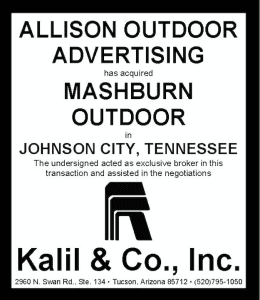 Columbus, OH headquartered DOmedia provides cloud-based technology to facilitate outdoor ad buying and selling. The firm’s platform powered approximately 5% of all US outdoor transactions during 2015. Insider asked DOmedia CEO Ken Sahlin for his thoughts on outdoor and automated buying.
Columbus, OH headquartered DOmedia provides cloud-based technology to facilitate outdoor ad buying and selling. The firm’s platform powered approximately 5% of all US outdoor transactions during 2015. Insider asked DOmedia CEO Ken Sahlin for his thoughts on outdoor and automated buying.
Ken, outdoor is one of the few forms of media spending which is growing at pace with the US economy. Why is that?
The steady rise in out-of-home media spend is the result of several factors. Out-of-home (OOH) media is really the last remaining “broadcast” channel. While digital advertising has given marketers many tools to reach “anybody,” the tools available to reach “everybody” are disappearing due to fragmentation. OOH is also becoming more attractive to marketers as data continues to emerge on positive impact on social and mobile marketing, particularly as a boost to earned impressions among valuable millennial consumers. These are all reasons OOH is an intrinsically powerful format — but the market is also being driven by technology. Workflow automation tools have made OOH much easier to plan, buy and measure effectively. Traditional media agencies are finding it easier to demonstrate the format’s value to clients, and newer digital agencies are increasingly seeing it as a promising area to extend the capabilities they offer. We have had great conversations with a number of firms that had focused solely on digital advertising, but will be leveraging our software to begin buying OOH. As the number of digital out-of-home assets continues to increase and those assets become web-connected, we expect this trend to accelerate even further.
 Your firm raised $3 million to expand its automated outdoor advertising marketplace in April 2016. How are things proceeding?
Your firm raised $3 million to expand its automated outdoor advertising marketplace in April 2016. How are things proceeding?
2015 was a great year for DOmedia in terms of growth, and the new funds are being used to accelerate that growth even further. Our newly-released supply-side platform (SSP) is getting great traction among a wide range of operators, and our industry-leading demand-side platform (DSP) has continued to grow briskly since January, when we opened it up to small and medium-sized agencies. So far this year, firms representing over $200 million in annual OOH dollars have signed up to begin using our DSP and SSP. We are extremely gratified at the reception our tools are receiving as we begin to roll them out more broadly.
How do you respond to skeptics who say that programmatic outdoor buying will be limited by the huge variety of outdoor media, a lack of addressability, fragmented trading platforms and a lack of standard audience data?
To be honest, those critics have valid points. We like to say the industry is on a strong “path toward programmatic.” Automation tools like ours are quickly laying the groundwork for programmatic buying, but there are still barriers to the kind of true programmatic solutions that allow agencies to buy audiences rather than locations. In terms of the challenges that exist in this context, the industry really isn’t as fragmented as people like to say. When you consider the formats and assets as percentage of the total spend, a small number of formats – posters, wallscapes, bulletins and transit – make up a large volume of what is bought. These formats have all been “standardized” and measured by Geopath, formerly the Traffic Audit Bureau, which gives independent assessments of their audience and impact. So there is standard audience data as well.
Another question, of course, is how much impact that data has on the price of an asset. In a programmatic world, two assets with nearly equivalent ratings should have nearly equivalent prices, without regard for location or what the market historically bought or sold them for. That is probably not the case today, but once programmatic solutions come into play the market itself will make those corrections. Ultimately, industry-wide utilization rates will increase and so will revenue. Even the lack of addressability isn’t too much of a challenge. Non-digital assets just need to build a certain amount of lag-time into a buy. They don’t make programmatic buying impossible.
The real challenge is getting buyers access to real-time availability. That’s where technology like our SSP comes into play. The more demand becomes aggregated in automated buying tools, DSPs, the more attractive similar, integrated, platforms will become to sellers. As automation continues to proliferate on the supply-side, programmatic buying will become increasingly common.
What two or three things have to happen for automated outdoor buying to continue to grow?
Buyers and sellers need to continue to adopt platforms that automate busy-work and allow them to focus on strategy and sales, respectively. Those tools — and the integration between them — have only just begun to reach the scale at which their impact can really be felt. In particular, sellers that can deliver real-time availability are positioned to have a huge impact on the marketplace. We think these developments are inevitable, as long as technology providers continue to prove their value to buyers and sellers.
The other big thing that has kept happening is continued support for our industry groups. Groups like the OAAA, TAB and DPAA are helping to chart a course for the industry. They have the best interests of the industry at heart, and they are at the forefront of creating the standards and connections that will push the OOH industry forward. Just look at the U.K. True, it is a much smaller market, but their industry groups made a huge impact this year when they rolled out SPACE, which created a unique identification code to find data on more than 500,000 assets. The U.S. OOH market is on the cusp of a similar technological revolution, as long as support remains strong for the industry groups that can make it possible.
Paid Ad

















